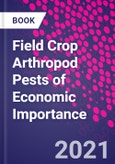Field Crop Arthropod Pests of Economic Importance presents detailed descriptions�of the biology and ecology of important arthropod pest of selected global field crops.
Standard management options for insect pest control on crops include biological, non-chemical, and chemical approaches. However, because agricultural crops face a wide range of insect pests throughout the year, it can prove difficult to find a simple solution to insect pest control in many, if not most, cropping systems. A whole-farm�or integrated pest management approach combines cultural, natural, and chemical controls to maintain insect pest populations below levels that cause economic damage to the crop. This practice requires accurate species identification and thorough knowledge of the biology and ecology of the target organism. Integration and effective use of various control components is often enhanced when the target organism is correctly identified, and its biology and ecology are known. This book provides a key resource toward that identification and understanding.
Students and professionals in agronomy, insect detection and survey, and economic entomology will find the book a valuable learning aid and resource tool.
Please Note: This is an On Demand product, delivery may take up to 11 working days after payment has been received.
Table of Contents
1. Arthropod pests of tobacco (Nicotiana tabacum L.)
2. Arthropod pests of sunflower (Helianthus annuus L.)
3. Arthropod pests of rapeseed (canola) (Brassica napus L.)
4. Arthropod pests of cotton (Gossypium hirsutum L.)
5. Arthropod pests of sugarcane (Saccharum officinarum L.)
6. Arthropod pests of sorghum (Sorghum bicolor (L.) Moench)
7. Arthropod pests of maize Zea mays (L.)
8. Arthropod pests of rice (Oryza sativa L.)
9. Arthropod pests of small grains: Wheat (Triticum aestivum L.) and Barley (Hordeum vulgare L.)
10. Arthropod pests of pulses
11. Arthropod pests of alfalfa (Medicago sativa L.)
12. Arthropod pests of soybean Glycine max (L.)
13. Arthropod pests of groundnut Arachis hypogaea L.
14. Arthropod pests of sugarbeet (Beta vulgaris L.)
15. Arthropod pests of hemp (Cannabis sativa L.)
Authors
Peter A. Edde Principal Scientist and Entomologist, Altria Client Services, LLC, Richmond, VA, USA. Dr. Peter A. Edde currently works at Altria Client Service LLC, Richmond, VA, USA. He leads efforts at addressing pest management issues and developing entomological solutions, and opportunities for all aspect of the business. His research has focused on using a multidisciplinary approach to address fundamental questions in insect behavior and olfaction with the objective to develop the tools required for biologically based management of field and storage insect pests.Dr. Edde also served as plant quarantine entomologist at the Federal Department of Agriculture, Nigeria. His PhD in entomology is from Oklahoma State University.








